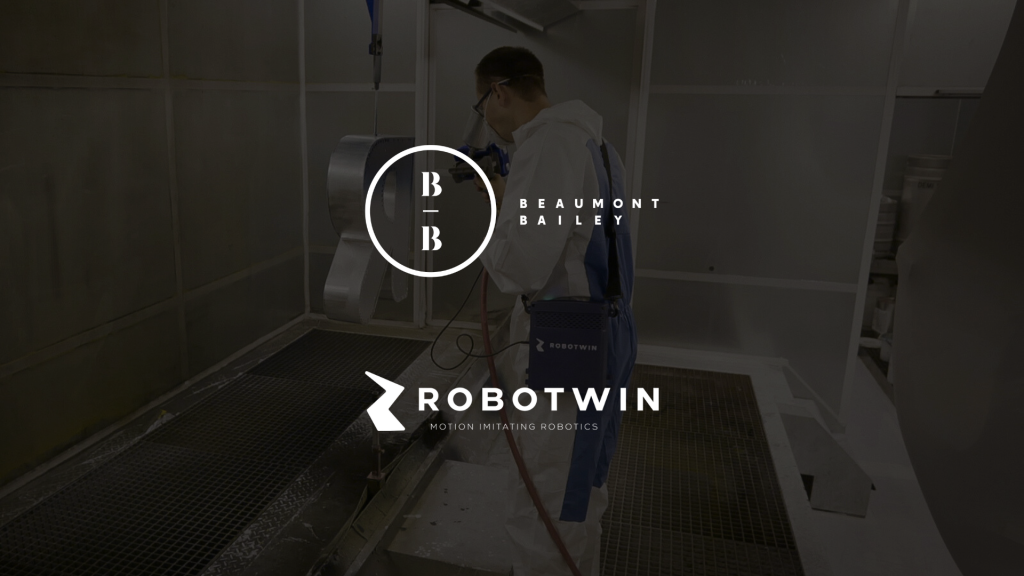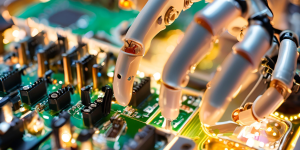Technology Spotlight: An Interview with RoboTwin
By Alex Catana

As part of Beaumont Bailey’s mission to connect founders, innovators, and key players that make up the fabric of our industry, our latest Technology Spotlight series highlights the success of our incredible members and wider network.
 In this instalment, we speak with Megi Mejdrechová, Co-Founder and CTO of RoboTwin – an award-winning startup revolutionising industrial automation through motion-imitating robotics.
In this instalment, we speak with Megi Mejdrechová, Co-Founder and CTO of RoboTwin – an award-winning startup revolutionising industrial automation through motion-imitating robotics.
A mechanical engineer by training, Megi holds a Master’s in Mechatronics from the Czech Technical University in Prague, with exchange terms at the University of Waterloo and Nanyang Technological University.
Her journey began in academia, where a collaboration with an industrial paint shop sparked a mission: to simplify robot programming for small- and medium-sized manufacturers. That insight led to a career spanning roles as a robotics engineer at Arculus and as a machine learning researcher, blending deep technical expertise with a practical, scalable approach to innovation.
At RoboTwin Megi leads the development of wearable technology that allows manual workers to program industrial robots by demonstration – eliminating the need for costly, time-consuming programming. Backed by the prestigious EIC Accelerator, the company is now expanding across Europe and North America.
Named one of Forbes 30 Under 30 and RIS Leaders’ Best Woman Innovator in Manufacturing, Megi is passionate about building open, diverse teams and creating solutions that make advanced automation accessible to everyone.
How did your journey start? What was your inspiration?
Years ago, while still in academia, we were approached by an industrial paint shop seeking help with automation. That experience opened my eyes to a broader issues: many small and medium-sized manufacturers still rely on manual processes, which are often extremely dirty, unhealthy, and unpleasant.
These companies want to automate – but their operations are so complex or variable that traditional automation is either technically unfeasible or prohibitively expensive. My goal became clear: to help streamline automation and reduce the number of hours people spend in toxic environments like manual paint shops.
That vision led me to develop a way to automate small-scale industrial painting efficiently and affordably – by tracking and imitating human motions.
What specific problem or market gap were you seeing at the time that led to the creation of RoboTwin?
European manufacturing still relies heavily on demanding, dirty, and often unhealthy jobs. While we continue to produce high-quality products, fewer people are willing to take on this kind of work. Add to that the strain of global conflicts and trade instability, and the pressure of the industry is mounting.
Traditional automation isn’t solving the problem. Instead of replacing manual labor, it’s introducing another bottleneck: expensive robot programmers who are hard to find and often lack the process-specific knowledge. Integration takes months and wastes resources. The real challenge lies in robot programming, and that’s the gap RoboTwin is addressing.
As a technical founder, what has your biggest challenge been so far?
One of the biggest challenges has been bringing the right people on board to complement my own skill set. Creating an innovative product is one thing, but scaling it and turning it into a business that delights customers requires excellence in sales, communication, and marketing. Recognising which skills were needed and building the right team – starting with the founding team – was critical. I had to learn quickly how to hire, identify my own blind spots, and be willing to delegate. Being honest about what I don’t know, and surrounding myself with people who are strong in those areas, has helped foster a culture of trust and transparency.
Staying open to outside advice, whether through mentors or accelerator programs, was also key. We’re still evolving and now actively scaling our team, with plans to grow from 13 to around 20–25 members in the next year.
Tell us a bit more about RoboTwin. What are your solutions & what makes them different from other players?
RoboTwin’s approach to robot programming uses motion tracking and imitation. It pairs workers directly with robots to automatically generate programs. An experienced worker demonstrates how the first product in a series should be manufactured, and RoboTwin captures that motion to create a robot program based on the data. The robot then completes the rest of the batch autonomously.
We train regular workers to become robot instructors – no need for specialised programmers or CAD models. Our wearable, easy-to-use devices generate programmes compatible with all major robot OEMs: FANUC, ABB, KUKA, Yaskawa, and Universal Robots. Workers can learn the system in a single day and produce robot programmes in just three clicks, using only one demonstration.
What types of customers or industries are you currently targeting? Who benefits the most from your solutions?
Our solution is ideal for manufacturers looking to automate manual production or enhance existing robotic systems. We digitise workers’ know-how and enable them to create robot programs without any prior programming experience. Just one demonstration is all it takes. This method is faster and more efficient than traditional approaches, and particularly valuable for SMEs in high-mix, low-volume environments.
Can you share an example or use case that shows the real-world impact of your technology?
In one powder coating facility, our solution greatly enhanced robot programming efficiency. Previously, the customer hired external programmers for each new product setup, and those programmes often required manual corrections because they weren’t technologically optimised. Now, thanks to our RoboTeach tool, a manual painter demonstrates the coating technique, generates the robot program in-house, and achieves improvements in both cost-efficiency and production quality.
What core problem(s) are you solving for your customers? How does RoboTwin’s technology improve their operations, productivity, or cost-efficiency?
The primary challenge manufacturers face is a lack of skilled labor. RoboTwin addresses this by empowering existing workers to become robot instructors and operators, boosting productivity without the need for external specialists. Valuable technical know-how remains in-house, and new robot programmes can be created quickly and cost-effectively. Onboarding takes just one day, and usable robot programmes can be generated immediately.
Where are you now in your start-up journey? Can you share a bit about your traction so far – pilot customers, partnerships, or feedback you’ve received?
Our go-to-market strategy focuses on gaining traction across all parts of the value chain. We work directly with manufacturers in surface treatment (wet painting, powder coating, grinding) and robotic assembly.
Our distribution partners are system integrators, particularly eager to serve SMEs – a fast-growing segment in automation investment. RoboTwin provides the flexibility and simplicity these businesses require.
We’ve also earned strong support from robot OEMs, who see RoboTwin as a key enabler of automation – helping them sell more robots.
In North America, especially the US and Canada, we’ve established strategic partnerships with leading system integrators and one of the largest FANUC robot resellers. These partners are key to piloting use cases and scaling effectively in new markets.
What’s the focus for the next 12–18 months at RoboTwin?
Our teaching method is applicable to a wide range of manufacturing operations. We aim to make automation accessible to everyone – from SMEs to large corporations – across painting, grinding, assembly, and quality control. Our vision is to become the go-to solution for industrial automation.
Are you looking at any specific industries, markets, or geographies as part of your expansion plans?
With the growing trend of onshoring, both Europe and North America require accessible automation solutions. While we began in Central Europe and the DACH region, we are now active in other European countries and expanding into the Americas. Our unique approach is attracting attention from manufacturers worldwide who face challenges with robot programming.
What kind of team or partnerships are you looking to build going forward?
We are focused on building partnerships with system integrators who deliver complete automation solutions. These collaborations enable us to reach end users efficiently and at scale.
Our current team includes 13 full-time employees, and we plan to grow to 20–25 over the next year. Around two-thirds of new hires will support product development, with the remainder strengthening our commercial presence in Europe and North America. Recruitment is already underway, with a focused hiring push planned for September.
Are you currently raising investment?
We recently closed our pre-seed round and secured a highly competitive European Innovation Council (EIC) Accelerator grant. Our current focus is on executing our development and expansion roadmap. A new investment round is anticipated at the end of the EIC grant period in 2027.
Any advice you’d give to fellow technical founders just starting out with an idea?
Stay close to the industry and your users; their feedback is your best guide to building something meaningful. Assemble a strong, complementary team, develop a prototype early, and test it in the market. Iterate quickly. Stay humble, trust your team, and remain open to constructive feedback.
 If you would like to discuss any of the topics raised in this piece or if you need support with your leadership resourcing strategy, please get in touch with Alex Catana on: alex.catana@beaumontbailey.com.
If you would like to discuss any of the topics raised in this piece or if you need support with your leadership resourcing strategy, please get in touch with Alex Catana on: alex.catana@beaumontbailey.com.




